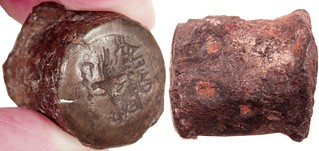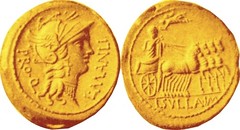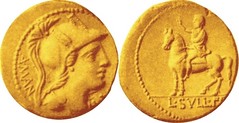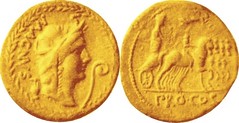Part 13 RRC 359 to RRC 404, 83BC to 70BC, Sulla's dictatorship to the consulship of Pompey and Crassus

|
Specialist Supplements:
1. Roman Coins of Luceria and Canusium
2. Anonymous Struck Bronze Coins of the Roman Republic
3. Anonymous Roman Republican Denarii and Victoriati (Steve Brinkman's site)
Principal Coins of the Roman Republic
Part 13 RRC 359 to RRC 404, 83BC to 70BC, Sulla's dictatorship to the consulship of Pompey and Crassus
RRC 359 L.SVLLA IMPER ITERVM Cornelia denarius. This issue of Sulla is presumed to to be a military issue relating to the invasion of Italy 83 BC (RRC p.80), perhaps struck in Greece or south Italy. It's crude manufacture rules out a later Rome mint issue.
RRC 360 L.CENSORIN Marcia with C.LIMETAN P.CREPVSI denarius. RRC 361 P.CREPVSI Crepusia denarii. RRC 362 C.MAMILI LIMETAN Mamilia denarius. The die-numbered denarii of Publius Crepusius have been extensively studied by T.V. Buttrey, see "The Denarii of P. Crepusius and Roman Republican Mint Organization" ANSMN 1976. This may be the fourth largest issue of the Roman Republic, after that of RRC 340 L.Piso Frugi, RRC 408 C.Piso Frugi, and RRC 352 L.Julius Bursio. There are just two die-cutters and I illustrate an example of each above. The so-called Marcia denarius type in fact combines all three moneyers names: Crepusia, Mamilia and Marcius Censorinus; each also struck their own types in what was clearly a prolific year for military expenditure, culminating in the battle of the Colline gate in 82 BC. Given the military uncertainty during the year it is perhaps surprising that Publius Crepusius or his mint managers had the quiet thinking time to dream up his combinations of control letters, symbols and numbers. The serrated Mamilia type is struck on a large well centred flan. The control letters of the Mamilia, in this case N above Mercury's head, are drawn from the letters in the moneyers name.
RRC 365 C VAL FLAC Valeria bronze die. This die is almost certainly that of an ancient forger, made to produce plated coins. Such dies were almost certainly made by impressing a real coin into heated bronze, and then as necessary completing the engraving by hand. In this case I suspect the main devices were successfully impressed from a coin but the die circle may have been completed by hand engraving. The level of detail on areas such as the eagles body and wing seems rather less than one would expect on an official coin. The left side of the die face lacks any engraving - perhaps the surface was insufficiently flat to accept the coin's impression or it may be due to later damage. A recently published compendium by Lucia Travaiani and Alessia Bolis, "Conii e scene di coniazione" Rome 2007, shows many examples of ancient dies, albeit almost all made with the purpose of forgery. Included within their book is a complete reprint of the classic "Ancient Dies and Coining Methods" by Cornelius Vermeule, London 1954.
RRC 362 C.MAMILI LIMETAN Mamilia imitative denarius. RRC 363 L.CENSOR Marcia denarius. RRC 364 Q.ANTO BALB Antonia denarius. RRC 366 C.ANNIVS PRO COS Annia denarius with L.FABI HISP Q. Fabia. The Mamilia is not a plated coin and is of very good style but dog Argos is not leaping to greet Ulysses and the surfaces of the coin suggest perhaps debased silver. This is perhaps a debased silver ancient imitation. The Annia is RRC 366/1a, see below for commentary.
RRC 366 C.ANNIVS PRO COS Annia, L.FABI HISP Q. Fabia, C.TARQVITI Tarquitia denarii. From left: RRC 366/2a, RRC 366/3a, RRC 366/3b, RRC 366/4. On this and the prior tray I illustrate five examples of RRC 366, a very complex series, struck in Spain and north Italy. For the minting arrangement I quote RRC p.386: "C.Annius was sent against Q.Sertorius in Spain some time after the middle of 82BC. The early part of the issue, struck in Italy [RRC p.80: the Monte Cadruzzo hoard contains examples only of RRC 366/1 and RRC 366/2] bears the name of one Quaestor, L.Fabius L.F. Hispaniensis. The later part, struck in Spain [ref. Poio hoard in Portugal, RRCH 305] beats also the name of C.Tarquitius P.F. The presence of two Quaestors at this stage is entirely intelligible if C.Annius was in charge of both Spanish provinces. C.Tarquitius was not heard of again. L.Fabius deserted to Sertorius, and shared in his murder" [Sertorius was murdered by his own officers in 72BC]. Thus Annius' issues have the Italian RRC 366/1 and 366/2 struck only with Fabius, and the Spanish RRC 366/3 and 366/4 struck with both Fabius and Tarquitius.
RRC 367 L.SVLLA IM Cornelia Sulla with L.MANLI T PRO Q Manlia denarii and aureus. All Davis coll. Crawford's RRC 367 variants depend on how Lucius Manlius' name is arranged around the head of Roma. The legend may start at 8pm (RRC 367/1) or 5pm (RRC 367/2/3/4/5) and/or may include T for Torquatus (RRC 367/2/3) or not (RRC 367/1/4/5). Phil Davis has suggested that a much more important distinction occurs on the reverse, between coins where the leading horse is either to the right of the quadriga, or to the left. On the above RRC 367/1 and RRC 367/3 the leading horse is to the right of the quadriga and the horses heads are reined back, and differs from the RRC 367/4 where the leading horse is to the left of the quadriga and the horses have their heads down as if in movement. Could these represent different scenes in Sulla's triumph?
RRC 368 L.SVLA IMPE Cornelia Sulla As, RRC 369 M.METELLVS Caecilia denarius, RRC 370 C.SERVEIL Servilia denarius, RRC 371 Q.MAX Fabia denarius. The As of Sulla is the last regular Janus Prow As issued under the Roman Republic, and the last bronze coin until the Imperatorial issues of Cnaeus Pompey and of Julius Caesar in the early 40s BC. It was struck at a significantly heavier standard than semuncial, at might represent the point when the semuncial coins were effectively demonetised or perhaps devalued after a mere 8 years in circulation. Certainly they do not appear in late hoards.
The Caecilia, Servilia and Fabia types issued by Sulla in 82BC are exact copies of RRC 263 Caecilia, RRC 264 Servilia and RRC 265 Fabia, all minted in 127BC, but with Roma's head changed in favour of Apollo. Crawford suggests that these restored coins were issued by Sulla with the family names and coin-types of prominent supporters including Q.Caecilius Metellus Pius (consul 80BC) and P.Servilius Isauricus (consul 79BC), so as to bypass the appointment of regular monetary magistrates and the regular approval of funds for coinage, i.e. these were effectively military issues of Sulla outwith normal civilian authority. Possibly a Q.Fabius Maximus was also a noted Sullani. However Crawford's suggestion does not easily explain why three types from the same year 127BC (the Consulship of Ravilla and Cinna) would be chosen. There would have been a myriad of possible prototypes from these families, many perhaps more apt to the era. A perhaps simpler explanation is that Sulla asked junior relatives of his friends, a Cornelia, Caecilia and a Fabia, to organise the coinage for 82BC. The three fellows conferred, and noted the coincidence of a Cornelia, Caecilia and a Fabia having being triumvirs monetales in 127BC and decided to copy the types, a very typical decision given the multitude of puns, allusions, and historical hark-backs seen on Republican coinage.
RRC 373 A.POST ALBIN Postumia denarii. RRC 373 Apollo Victory quinarius RRC 374 Q.C.M.P.I. Metellus Pius Caecilia denarius. Q.C.M.P.I. stands for Quintus Caecilius Metellus Pius Imperator
RRC 374 IMPER Caecilia denarius, RRC 375 Q Sulla Cornelia denarius, RRC 377 L.VLO. L.F. STRABO Volteia denarius, RRC 378 C.MARI Maria denarius.
RRC 379 L.PROCILI Procilia denarius, RRC 380 C.POBLICI Poblicia denarius, RRC 382 C.NAE BALB Naevia denarius, RRC 383 TI.CLAVD Claudia denarius.
RRC 379 L.PROCILI Procilia denarius, RRC 381 L.SVLLA FELIX DIC Cornelia Sulla with A.MANL A.F.Q. Manlia aureus. This aureus of Sulla is the dust-jacket cover coin for the 1974 first edition of Crawford's RRC.
RRC 384 L.PAPI Papia denarius, RRC 385 M.VOLTEI Volteia denarii.
RRC 385 M.VOLTEI S.C.D.T. Volteia H&W 75BC denarius, RRC 386 C.CASSI Cassia H&W 75BC denarius, RRC 387 L.RVTILI Rutilia H&W 77BC denarius, RRC 389 L.RVSTI Rustia H&W 74BC denarius.
Coins in the period from Sulla's death in 78BC to 50BC are difficult to date. There are few hoards, and issue volumes are small. Types are often represented by only a few examples in any except the largest hoards, which are still dominated by the vast coinage of the Social War. I wish to quantify the problem faced by Michael Crawford in order to explain it. RRC table XII presents hoards whose latest coin is dated between 78BC and 49 BC. The large Roncofreddo and Frascarolo hoards are useless for quantifying issues because they only list whether a type was present or not. Of the remainder, the ten largest hoards included 8943 coins. These, in approximate date order, are Maccarese (1226 coins), Pontecorvo (1233 coins), Potenza Picena (448 coins), Cosa (2004 coins), Ossero (475 coins), Villa Potenza (427 coins), San Gregorio di Sassola (563 coins), Frauendorf (also 563 coins), Compito (972 coins) and Casaleone (1032 coins). These 8943 coins included 1031 coins of the period 78BC to 49BC, i.e almost all the coins in hoards ending in this period are from the Social War or earlier periods. The 1031 coins of the period in these 10 large hoards are divided among 57 issues of the period. So, on average, each large hoard contained just 2 coins of each issue of the period.
Furthermore, the distribution of coins of the period between hoards is erratic, although probably no more erratic than would be found in other small sample hoards. As an example the Maccarese hoard had 1226 coins ending in 72BC of which 152 coins date from this period. The Pontecorvo hoard has 1233 coins ending 71BC of which 36 coins date from this period. So in two identically sized and dated hoards, one contains four times as many late-period coins as the other. Perhaps Pontecorvo included coins collected over time and Maccarese represented the circulation mix. We just do not know. The fundamental problem is that sample sizes in the period are just too small. We are attempting to arrange and date coins based on tiny occurrence numbers in relatively small hoard samples which might not even be representative of the circulation mix of the period. Crawford in any event did his best to arrange the coins with the data available.
What was needed was a single very large hoard dated relatively late in the period and thus containing a large sample of coins of this period. Exactly such a hoard was discovered in 1980, when 5940 denarii were unearthed at Mesagne in Calabria. The hoard included examples of RRC 422, the Curule Aedile issue of Scaurus and Hyspaeus that can be positively dated to 58BC, but it did not include any other issue dated by Crawford after 58BC. 2254 of the coins in the hoard post-dated 78BC. Comparing with my comments above, Mesagne provided twice as many post-78BC denarii as all the hoards on RRC table XII combined. Barring certain evidence to the contrary, presence or absence from Mesagne should be the determinant of whether a coin pre-dates or post-dates 58BC for all except the rarest of issues. In fact Mesagne missed two very large issues that Crawford had dated prior to 58BC, namely RRC 405 Plaetoria and RRC 410 Pomponia. Each has between 100 and 200 counted dies, and would have been present in many dozens of examples in Mesagne if their RRC dating was correct. The hoard was documented by Charles Hersh and Alan Walker in ANS Museum Notes 1984. Hersh and Walker proposed a new dating, and I cite this in for every coin after 78BC in this part 13 and the next part 14 of the Ahala collection, although for consistency and ease of reference I keep the arrangement as per RRC. So, dates are cited after RRC numbers thus: RRC 386 C.CASSI Cassia H&W 75BC denarius. I do not also cite the Crawford date - they have been superseded due to new facts from the Mesagne hoard.
Minor variations in Mesagne-based dating have been proposed by others including by Wilhelm Hollstein in "Die stadtrömische Münzprägung der jahre 78-50 v.Chr. zwischen politischer Aktualität und Familienthematik", 1993 and by Harold B. Mattingly in "The Mesagne Hoard and the Coinage of the Late Republic", NC 1995. I have no strong opinions as to relative merits of the Hersh and Walker, Hollstein or HB Mattingly dates, which differ from each other by at most a year or two, but I choose to cite Hersh and Walker, which is considered as standard.
The dates proposed by Michael Harlan in "Roman Republican Moneyers and their Coins, 81 BCE to 64 BCE", 2012, and in "Roman Republican Moneyers and their Coins, 63BC to 49BC", 1995, are fundamentally wrong and should be ignored. Harlan's dating contradicts evidence from the Mesagne hoard without reasonable explanation, e.g. in incorrectly dating both RRC 405 and RRC 410 prior to the hoard. He also over-interprets other hoards without an understanding of the statistical variability that I discuss above, and supports his dating ideas with unsubstantiated theories on mint management and with weak evidence on issue financing.
RRC 390 L.LVCRETI TRIO Lucretia H&W 74BC denarii, RRC 391 C.EGNATIVS Egnatia H&W 76BC denarii.
RRC 391 C.EGNATIVS Egnatia H&W 76BC denarius, RRC 392 L.FARSVLEI H&W 76BC denarius, RRC 393 CN.LEN.Q Cornelia H&W 76-75BC denarius, RRC 395 L.COSSVTI Cossutia H&W 72BC denarius.
RRC 396 L.PLAETORI Plaetoria H&W 71BC denarii. The denarii of Plaetoria form a very interesting set of games or agonistic types. The runner with palm-branch has, on his hand, either a boxer's cestus with loose ribbons, or perhaps is just holding a fillet (ribbon) that may be later placed as a headband. The three coins at right have symbols relating to games activities: oil jug, discus and torch.
RRC 396 L.PLAETORI Plaetoria H&W 71BC denarius, RRC 397 P.LENT Cornelia H&W 71BC denarius, RRC 398 Q.POMPONI Pomponia H&W 70BC denarius, RRC 399 Q.CREPER Crepereia H&W 69BC denarius. The Cornelia and the Pomponia types are of very great rarity. Neither were present in Mesagne but their genuine rarity means they would not be expected even in a hoard of thousands.
RRC 400 L.AXIVS NASO Axia H&W 70BC denarii, RRC 403 KALENI CORDI Fufia H&W 68BC denarius RRC 404 T.VETTIVS SABINVS Vettia H&W 66BC denarius.
RRC 402 MAGNVS PRO COS Pompey 71BC aureus. RRC 402 keeps its Crawford RRC date of 71BC by default as it is not susceptible to hoard dating.
Specialist Supplements:
1. Roman Coins of Luceria and Canusium
2. Anonymous Struck Bronze Coins of the Roman Republic
3. Anonymous Roman Republican Denarii and Victoriati (Steve Brinkman's site)
All content copyright © 2004-2013 Andrew McCabe unless otherwise noted. If you've any questions or comments please contact me on the Yahoo Group RROME: http://groups.yahoo.com/group/RROME.
Alternately you can leave comments against any coin picture, just click on the picture and write in the comment box.
Site hosted free courtesy of VCoins.com
Ancient Coins on Vcoins
comment: this page is RRC359.html

































